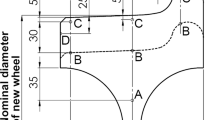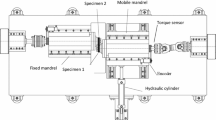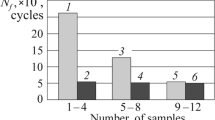Abstract
Worn railway wheels after service in the desert were investigated by means of failure analysis, hardness measurements, tensile tests, fracture toughness tests and low-cycle fatigue (LCF) tests. The results complete both previous small-scale laboratory experiments and FEM simulations performed by the authors on widely used steels and new steel grades allowing to better understand the main damage mechanisms due to the sand. These new steel grades were developed for forged-rolled solid wheels in alternative to AAR Class B/C/D steel grades and were designed to ensure high resistance to wear and rolling contact fatigue in the presence of sand, debris or gravel on the rails. This paper covers the in-depth mechanical characterization of wheels made of the new steels. Hardness measurements, tensile tests, fracture toughness tests and LCF tests were carried out. The results are compared with AAR Class B/C/D steels showing an excellent combination of fracture toughness, cyclic yield strength and ductility.





Similar content being viewed by others
References
M. Faccoli, C. Petrogalli, M. Lancini, A. Ghidini, and A. Mazzù, Effect of Desert Sand on Wear and Rolling Contact Fatigue Behaviour of Various Railway Wheel Steels, Wear, 2018, 396-397, p 146–161
A. Ghidini, M. Faccoli, and A. Mazzù, SANDLOS® wheels for desert environments, in LRS-TECHNO, vol 10, 2017. ISBN: 9788885467019.
M. Faccoli, A. Ghidini, and A. Mazzù, Experimental and Numerical Investigation of the Thermal Effects on Railway Wheels for Shoe-Braked High-Speed Train Applications, Metall. Mater. Trans. A, 2018, 49, p 4544–4554
M. Diener and A. Ghidini, Fracture Toughness: A Quality Index for Railway Solid Wheels, Mater. Perform. Charact., 2014, 3(3), p 286–304
H. Soares, T. Zucarelli, M. Vieira, M. Freitas, and L. Reis, Experimental Characterization of the Mechanical Properties of Railway Wheels Manufactured Using Class B Material, Procedia Struct. Integr., 2016, 1, p 265–272
A. Ghidini, M. Diener, and J. Schneider, Wheels for freight cars, in LRS-TECHNO, vol 3, 2010.
M. Faccoli, C. Petrogalli, M. Lancini, A. Ghidini, and A. Mazzù, Rolling Contact Fatigue and Wear Behavior of High Performance Railway Wheel Steels Under Various Rolling-Sliding Contact Conditions, J. Mater. Eng. Perform., 2017, 26(7), p 3271–3284
R. Lewis and U. Olofsson, Ed., Wheel-Rail Interface Handbook, CRC Press, Boca Raton, 2009, p 221–223
A. Mazzù, C. Petrogalli, and M. Faccoli, An Integrated Model for Competitive Damage Mechanisms Assessment in Railway Wheel Steels, Wear, 2015, 322-323, p 181–191
D.G. Grieve, R.S. Dwyer-Joyce, and J.H. Beynon, Abrasive Wear of Railway Track by Solid Contaminants, Proc. Inst. Mech. Eng. Part F, 2001, 215, p 193–205
R. Lewis and R.S. Dwyer-Joyce, Wear at the Wheel/Rail Interface When Sanding is Used to Increase Adhesion, Proc. Inst. Mech. Eng. Part F, 2006, 220, p 29–41
O. Arias-Cuevas, Z. Li, and R. Lewis, A Laboratory Investigation on the Influence of the Particle Size and Slip During Sanding on the Adhesion and Wear in the Wheel-Rail Contact, Wear, 2011, 271, p 14–24
X. Cao, W.L. Huang, C.G. He, J.F. Peng, J. Guo, W.J. Wang, Q.Y. Liu, and M.H. Zhu, The Effect of Alumina Particle on Improving Adhesion and Wear Damage of Wheel/Rail Under Wet Conditions, Wear, 2016, 348-349, p 98–115
W. Huang, X. Cao, Z. Wen, W. Wang, Q. Liu, M. Zhu, and X. Jin, A Subscale Experimental Investigation on the Influence of Sanding on Adhesion and Rolling Contact Fatigue of Wheel/Rail under Water Condition, J. Tribol., 2017, 139(1), p 11401–11408
A. Mazzù, C. Petrogalli, M. Lancini, A. Ghidini, and M. Faccoli, Effect of Wear on Surface Crack Propagation in Rail-Wheel Wet Contact, J. Mater. Eng. Perform., 2018, 27(2), p 630–639
A. Ghidini, M. Diener, and J. Schneider, Special wheels for mass transit, in LRS-Techno Series, vol 7 (Lucchini RS, Lovere, 2014). ISBN: 9788890624063.
T. Makino, T. Kato, and K. Hirakawa, The Effect of Slip Ratio on the Rolling Contact Fatigue Property of Railway Wheel Steel, Int. J. Fatigue, 2012, 36, p 68–79
T. Zucarelli, L. Moreira Filho, H. Soare, M. Vieira, and L. Reis, Experimental Characterization of the Mechanical Properties of Railway Wheels Manufactured Using Class C Material, Theor. Appl. Fracture Mech., 2016, 85, p 134–139
M. Faccoli, C. Petrogalli, M. Lancini, A. Ghidini, and A. Mazzù, Rolling Contact Fatigue and Wear Behavior of High Performance Railway Wheel Steels Under Various Rolling-Sliding Contact Conditions, J. Mater. Eng. Perform., 2017, 26(7), p 3271–3284
A. Ghidini, M. Diener, A. Gianni, and J. Schneider, SUPERLOS innovative steel by Lucchini RS for high-speed wheel application, LRS-TECHNO, in LRS-TECHNO, vol 5, 2012. ISBN: 9788890624049.
J. Sun, K.J. Sawley, and D.H. Stone, Progress in the reduction of wheel spalling, in Proceeding of the 12th International Wheelset Congress, Qingdao, 21–25 Sept 1998, p 18–29.
C. Lonsdale and D. Stone, North American Axle Failure Experience, Proc. Inst. Mech. Eng. Part F J. Rail Rapid Transit, 2004, 218(4), p 293–298
A. Ghidini, M. Lombardi, M. Vignola, and P. Kuokkanen, The finnish experience: A research to develop new steel grades for solid wheels with high in service performances, in Proceedings of Rolling Contact Fatigue Congress, Brescia, 2002.
B. Garbarz and R. Kuziac, The effect of micro-alloying on microstructure and properties of medium and high-carbon ferrite-pearlite steels (0.25–0.80%C), in Proceedings Micro-alloying’95, Gliwice, 1995, p 409.
U. Singh, A. Popli, D. Jain, B. Roy, and S. Jha, Influence of Microalloying on Mechanical and Metallurgical Properties of Wear Resistant Coach and Wagon Wheel Steel, J. Mater. Eng. Perform., 2003, 12, p 573–580
Y. Sawada, R.P. Foley, S.W. Thomson, and G. Krauss, Microstructure-property relationship in plain-carbon, and V and V+Nb microalloyed medium carbon steels, in Proc. 35th MWSP.ISS-AIME., vol XXXI (Dept. of Metallurgical and Materials Eng., Colorado School of Mines, Golden, 1994), p 263–86.
S.W. Thompson and G. Krauss, Precipitation and Fine Structure in Medium-Carbon Vanadium and Vanadium/Niobium Microalloyed Steels, Metall. Trans., 1989, 20A, p 2279–2288
L.A. Touryan, S.W. Thompson, and G. Krauss, Microstructure and properties of medium-carbon steels microalloyed with V and Nb, in Proc. Microalloyed Bar and Forging Steels, ed. by M. Finn (CIMM, 1990), p 63–83.
Author information
Authors and Affiliations
Corresponding author
Additional information
Publisher's Note
Springer Nature remains neutral with regard to jurisdictional claims in published maps and institutional affiliations.
Rights and permissions
About this article
Cite this article
Faccoli, M., Petrogalli, C. & Ghidini, A. On Mechanical Properties of New Railway Wheel Steels for Desert Environments and Sand Caused Wheel Damage Mechanisms. J. of Materi Eng and Perform 28, 2946–2953 (2019). https://doi.org/10.1007/s11665-019-04049-4
Received:
Revised:
Published:
Issue Date:
DOI: https://doi.org/10.1007/s11665-019-04049-4




